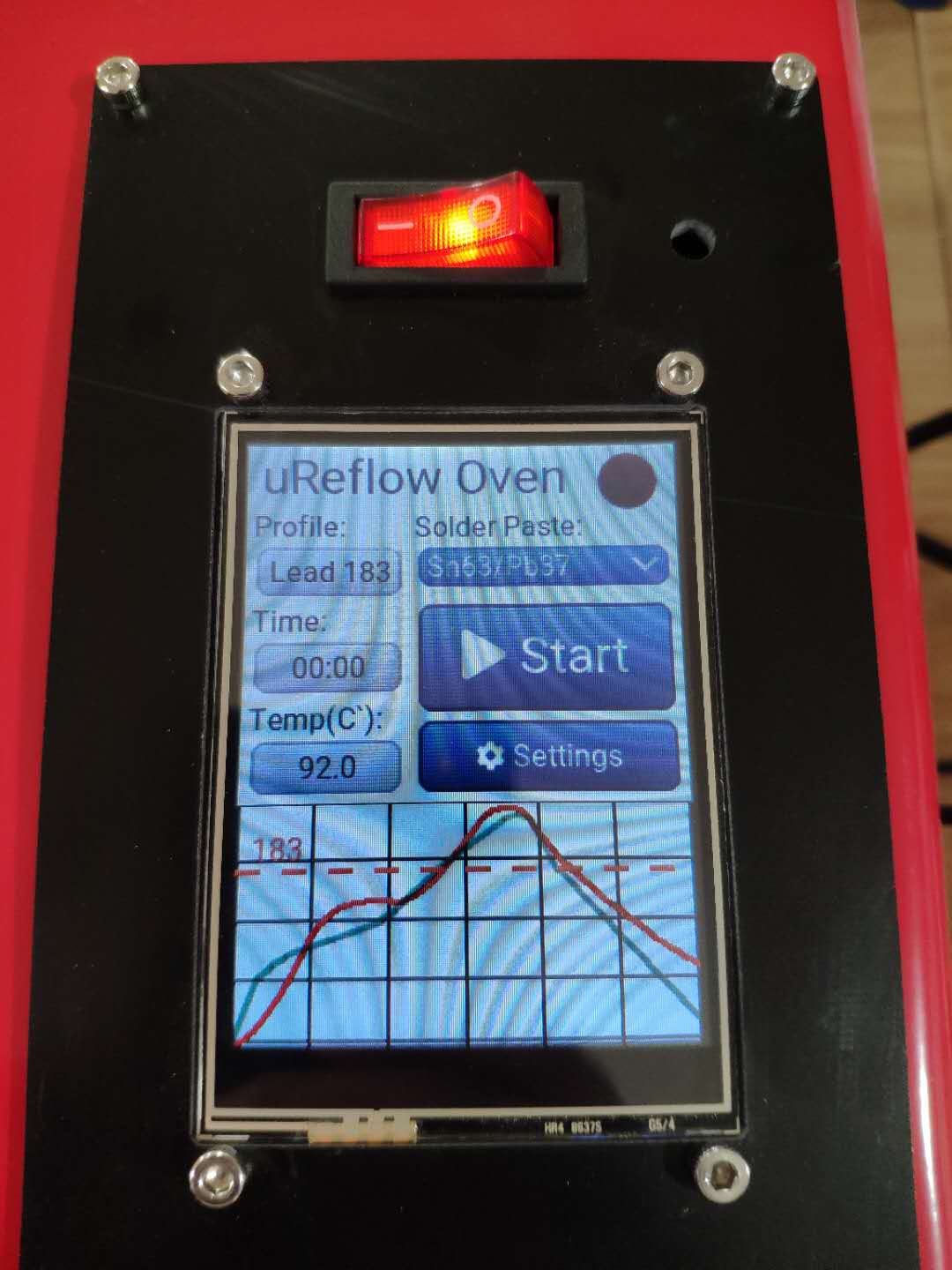Updated! Now the μReflow Oven is PID control enabled!
For previous version which is non-PID controlled, pls see the branch Adafruit-EZ-Make-Oven-alike.
This project is an improved and heavily modified version of Adafruit EZ Make Oven. The original code of EZ Make Oven can be found here.
The purpose is to make a reflow soldering oven by modifying a kitchen oven with more affordable and widely available hardwares.
The GUI of this project is built with LittlevGL (lv_binding_micropython) which is a very powerful and easy to use GUI library. LittlevGL already comes with drivers for ILI9341 TFT display and XPT2046 touch controller, this project takes the advantage of both to ease the user operation.
- 1 x regular kitchen oven with 10-12L capacity. Like this.
- 1 x solid state relay rated 10A. Like this.
- 1 x passive piezo buzzer. Like this.
- 1 x ILI9341 TFT display with on-board XPT2046 touch controller. Like this.
- 1 x MAX31855 thermocouple amplifier with K-thermocouple. Like this.
- 1 x AC-DC5v power supply to power the ESP32 dev board. Like this.
- 1 x ESP32 dev board. Like this.
- WARNING: The mains (220/110V) can be deadly. Make sure the oven is unplugged from the wall plug before doing any modification or wiring.
- Ovens are different one from another, but basically all you need to do is to bypass the original switch and timer, and let the solid state relay control the heating element, hence the ESP32 board can turn the heating element on and off via the solid state relay.
- Pls refer to here.
- Configuration is done by editing the
config.jsonfile. - Hardware wiring: edit the value of the key names ending with '_pins' to match your actual wiring.
- The TFT screen and the touch controller share the same
Clock,Data In&Data Outpins. - The ACC pin of the TFT screen is for powering on the display.
sampling_hzdetermines the update rate of the temp sensor and the PID controller. The default setting5means 5HZ which is 5 times per second.temp_offset&pidparameters can be set in the settings of the GUI.advanced_temp_tuningcan only be changed by editing theconfig.json.preheat_until(temperature in Celsius) is used to set a temperature below which the oven will always be on - it helps to heat up the oven as quickly as possible at the early stage.provisioning(time in Second) is for the PID to look for the set temp X seconds ahead, as the reflow temperature profile is not constant but a changing curve, this parameter will make the PID more reactive.overshoot_comp(temperature in Celsius) it helps reduce the overshoot.
- The above mentioned
advanced_temp_tuningmay need some trial and error. To make the fine tuning process a bit easier, the ESP32 will create a WiFi access point nameduReflow Oven ftp://192.168.4.1 - Simply connect to that SSID and you can edit the
config.jsonby logging in 192.168.4.1:21 via an FTP client, e.g.FileZiila.
- All files are under
MAINfolder. - After flashing the firmware, you need to edit
config.jsonto change the GPIO pin numbers according to how you wiring your TFT display and other components. - Transfer all the files and folder under
MAINto the ESP32 dev board and you are good to go.
- Upon powering on the first time, you will be guided through touch screen calibration, once finished, the ESP32 will reboot.
- After calibration and reboot, the GUI will load, where you can select Solder Paste type from the drop-down menu, just choose the type you'll use, and the reflow temperature profile will show down below.
- If your solder paste isn't there in the menu, you can build your own solder profile files. Pls refer to:
https://learn.adafruit.com/ez-make-oven?view=all#the-toaster-oven, under chapter "Solder Paste Profiles".
The new solder profile json file should be put under folder
profiles. - All set and click "Start" button to start the reflow soldering procress.
- If you wish to re-calibrate the touch screen, click the 'Settings' button on the screen, and choose from the popup window. And follow the on-screen instruction.



